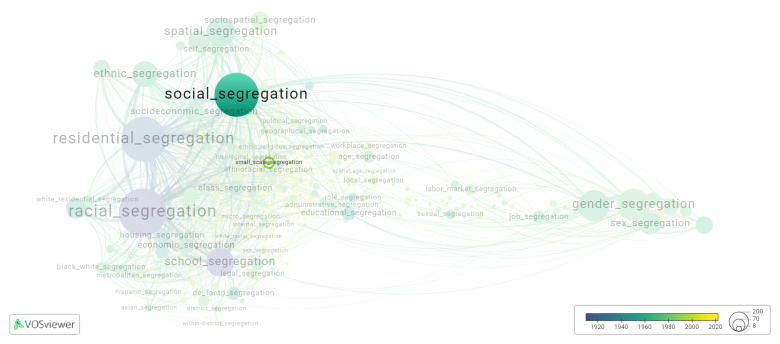Small scale segregation
Date and country of first publication[1]
2000
Germany
Definition
Small scale segregation refers to the separation or division of communities or individuals based on certain factors such as race, ethnicity, socio-economic status, or religion on a smaller scale. This can occur within neighborhoods, schools, workplaces, or other social settings. Unlike large-scale or systemic segregation, small scale segregation may be less visible or overt, but it still perpetuates inequality and creates barriers to equal opportunities and social integration.
See also
Related segregation forms
Small scale segregation is frequently discussed in the literature with the following segregation forms:
social segregation, ethnic segregation, racial segregation, residential segregation, socioeconomic residential segregation

For the complete network of associated segregation forms, see:
year of publication https://tinyurl.com/2235lkhw
Louvain clusters https://tinyurl.com/2d8wg5n3
betweenness centrality https://tinyurl.com/223udk5r
disciplines where segregation forms first appeared https://tinyurl.com/244d8unz
References
Notes
- ↑ Date and country of first publication as informed by the Scopus database (December 2023).
At its current state, this definition has been generated by a Large Language Model (LLM) so far without review by an independent researcher or a member of the curating team of segregation experts that keep the Segregation Wiki online. While we strive for accuracy, we cannot guarantee its reliability, completeness and timeliness. Please use this content with caution and verify information as needed. Also, feel free to improve on the definition as you see fit, including the use of references and other informational resources. We value your input in enhancing the quality and accuracy of the definitions of segregation forms collectively offered in the Segregation Wiki ©.
Small scale segregation appears in the following literature
Hanhörster H. (2). Whose neighbourhood is it? Ethnic diversity in urban spaces in Germany. GeoJournal, 51(4), 329-338. https://doi.org/10.1023/A:1012273014512
Berger G., Kaechele H., Pfeffer H. (2006). The greening of the European common agricultural policy by linking the European wide obligation of set aside with voluntary agri environmental measures on a regional scale. Environmental Science and Policy, 9(6), 509-524. https://doi.org/10.1016/j.envsci.2006.05.006
Gruner S. (201). 'The Others Don't Want ...'. Small scale segregation: Hegemonic public discourses and racial boundaries in German neighbourhoods. Journal of Ethnic and Migration Studies, 36(2), 275-292. https://doi.org/10.1080/13691830903387402
Sánchez-Uriarte P.M., Gómez-Maturano R. (2021). Spatial and aspatial indicators: A complementary approach to the quantitative analysis of residential segregation in Managua; [INDICADORES ESPACIALES Y NO ESPACIALES: UN ENFOQUE COMPLEMENTARIO PARA EL ANÁLISIS CUANTITATIVO DE LA SEGREGACIÓN RESIDENCIAL EN LA CIUDAD DE MANAGUA]. Urbano, 24(43), 52-61. Universidad del Bío Bío.https://doi.org/10.22320/07183607.2021.24.43.05
